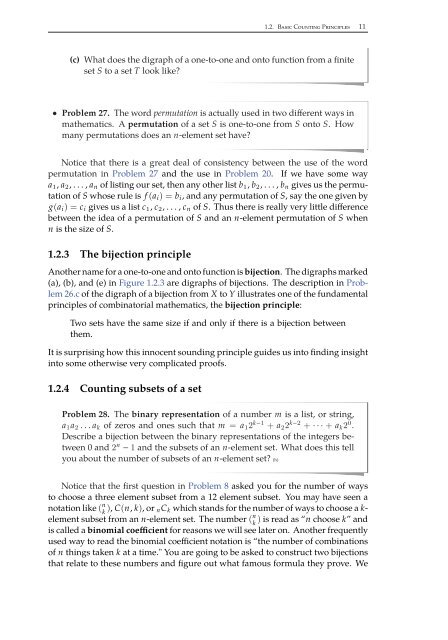Combinatorics Through Guided Discovery, 2004a
Combinatorics Through Guided Discovery, 2004a
Combinatorics Through Guided Discovery, 2004a
Create successful ePaper yourself
Turn your PDF publications into a flip-book with our unique Google optimized e-Paper software.
1.2. Basic Counting Principles 11<br />
(c) What does the digraph of a one-to-one and onto function from a finite<br />
set S to a set T look like?<br />
• Problem 27. The word permutation is actually used in two different ways in<br />
mathematics. A permutation of a set S is one-to-one from S onto S. How<br />
many permutations does an n-element set have?<br />
Notice that there is a great deal of consistency between the use of the word<br />
permutation in Problem 27 and the use in Problem 20. If we have some way<br />
a 1 , a 2 ,...,a n of listing our set, then any other list b 1 , b 2 ,...,b n gives us the permutation<br />
of S whose rule is f (a i )=b i , and any permutation of S, say the one given by<br />
g(a i )=c i gives us a list c 1 , c 2 ,...,c n of S. Thus there is really very little difference<br />
between the idea of a permutation of S and an n-element permutation of S when<br />
n is the size of S.<br />
1.2.3 The bijection principle<br />
Another name for a one-to-one and onto function is bijection. The digraphs marked<br />
(a), (b), and (e) in Figure 1.2.3 are digraphs of bijections. The description in Problem<br />
26.c of the digraph of a bijection from X to Y illustrates one of the fundamental<br />
principles of combinatorial mathematics, the bijection principle:<br />
Two sets have the same size if and only if there is a bijection between<br />
them.<br />
It is surprising how this innocent sounding principle guides us into finding insight<br />
into some otherwise very complicated proofs.<br />
1.2.4 Counting subsets of a set<br />
Problem 28. The binary representation of a number m is a list, or string,<br />
a 1 a 2 ...a k of zeros and ones such that m = a 1 2 k−1 + a 2 2 k−2 + ···+ a k 2 0 .<br />
Describe a bijection between the binary representations of the integers between<br />
0 and 2 n − 1 and the subsets of an n-element set. What does this tell<br />
you about the number of subsets of an n-element set? (h)<br />
Notice that the first question in Problem 8 asked you for the number of ways<br />
to choose a three element subset from a 12 element subset. You may have seen a<br />
notation like ( n k ), C(n, k),or nC k which stands for the number of ways to choose a k-<br />
element subset from an n-element set. The number ( n )<br />
k<br />
is read as “n choose k” and<br />
is called a binomial coefficient for reasons we will see later on. Another frequently<br />
used way to read the binomial coefficient notation is “the number of combinations<br />
of n things taken k at a time." You are going to be asked to construct two bijections<br />
that relate to these numbers and figure out what famous formula they prove. We


















